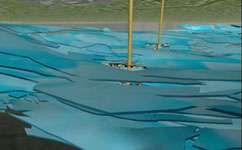City heat from ancient mines

People living in Glasgow could get around 40% of the energy they need to heat their homes and businesses from tapping into the rocks and water in old abandoned mineshafts and other mine workings beneath the city.
NERC's British Geological Survey (BGS) is working with Glasgow City Council to work out which parts of the city could best supply 'geothermal' energy from this source. The researchers believe it could help Glasgow meet government targets to lower carbon emissions and supply 11% of heat from renewable sources by 2020.
Dr. Diarmad Campbell, BGS Chief Geologist for Scotland, said, "There is a lot of heat stored in the rocks and minewaters beneath the city. We estimate that about 1% of this - which translates to around 60 liters of water per second for each square kilometer - can be removed each year and this could provide Glasgow with a low-carbon energy source for at least the next 100 years."
Using detailed 3D models produced from historical mining records and other data, the research team is able to predict the geology and depths of the mine-workings beneath any point in central Glasgow.
"Ground-source heating and cooling schemes are dependent on having access to water in a useable form, and any extraction of water will involve investment. The great advantage of minewater is that it's free-flowing water in open tunnel systems, so by reducing the uncertainty of where the water can be found we can help energy providers, working with the Coal Authority and others, to develop ground-source systems in a cost-effective way," said Campbell.
Heat pumps, which work in a similar way to fridges, can be used to concentrate heat energy from water in the mines to make the water hot enough to warm the city's houses and offices. During the summer the system can be reversed to keep hospitals and other buildings cool, whilst the excess heat is stored underground for use in the winter.
"This is long-term thinking," says Campbell. "But the potential is there to utilize energy sources whilst safeguarding the ecosystems surrounding them."
Leader of the City Council, Gordon Matheson, said "We want developers and local communities to come forward in the future with projects which could use this new source of heating and help ensure that everyone in Glasgow is able to benefit from the new green energy revolution."
Provided by PlanetEarth Online
This story is republished courtesy of Planet Earth online, a free, companion website to the award-winning magazine Planet Earth published and funded by the Natural Environment Research Council (NERC).
















